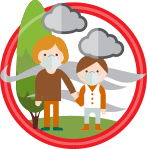What is PM10 and PM2,5?
Particulate matter (PM) consists of solid and liquid particles suspended in the air and being a mixture of organic and inorganic substances. May contain toxic substances such as polycyclic aromatic hydrocarbons (PAHs), including benzo(a)pyrene, heavy metals as well as dioxins and furans.
PM10 contains particles smaller than 10 micrometers that can reach the upper respiratory tract and lungs, while PM2.5 contains particles smaller than 2.5 micrometers that can also enter the blood.

The highest PM emission is caused by burning coal and wood in old boilers and household stoves. An important source is waste burning, which is illegal and causes a serious threat to human health. The quality of coal burned is also important.
Significant PM emissions are caused by transport – both as a result of combustion of fuels in engines, as well as as a secondary emission from raising dust from dirty and poor roads.
PM emissions are also caused by industry, especially energy, chemical, mining and metallurgical industries, but due to the height of emitters and applicable regulations limiting emission limit values, these sources usually have a much smaller impact on air quality.

Impact on health
Effects of long-term exposure
Air pollution with PM and benzo(a)pyrene contributes to:
- respiratory diseases: asthma, lung cancer, chronic obstructive pulmonary disease, frequent respiratory tract infections,
- blood disorders: heart attacks, hypertension, coronary heart diseases, cardiac arrhythmias, heart failure,
- nervous system disorders: memory and concentration problems, higher anxiety levels, depressive states, anatomical changes in the brain, Alzheimer’s disease, accelerated aging of the nervous system, strokes,
- reproductive system diseases: infertility, premature delivery, fetal death.

Problems with memory and concentration
Higher levels of anxiety, depressive states, anatomical changes in the brain

Breathing problems
Breathing problems, eye, nose, throat irritation, cough, runny nose, sinusitis

Myocardial infarction, hypertension
Ischemic heart disease, arrhythmia, heart failure

Asthma, lung cancer
Chronic obstructive pulmonary disease, frequent respiratory infections

Infertility, fetal death
Premature birth
Polluted air also has a negative effect on the fetus. Research conducted by the team of prof. Wiesław Jędrychowski from the Collegium Medicum of the Jagiellonian University prove that women who breathed air with a high concentration of benzo(a)pyrene during pregnancy give birth to children of lower height, with lower birth weight, a smaller head circumference and a lower IQ. These children are less resistant to infections later in life.
Download the report (in Polish): Air pollution in Krakow and children's health
Short-term exposure to suspended particulate matter
Even relatively short exposure to PM is dangerous, especially at high concentrations. Children, the elderly and people suffering from cardiovascular or respiratory diseases are particularly at risk. Studies show that in a given age group people with low socioeconomic status are the most sensitive to the impact of air pollution.
Many studies have shown that short-term exposure to PM2.5 significantly increases the risk of death. The main reason is cardiovascular discomfort, but also the risk of myocardial infarction or cardiac arrest. Other health effects of short-term exposure to PM are also increased blood pressure, worsening of bronchial asthma symptoms, and increased incidence of respiratory infections, including pneumonia.
What steps should be taken to reduce exposure

Limit long walks

Restrict children’s activity outside

Avoid airing the apartment

Do not play sports outside

Turn on the air purifier

Put on the anti-smog mask

Contact a doctor if necessary

Follow information on air quality on powietrze.malopolska.pl



